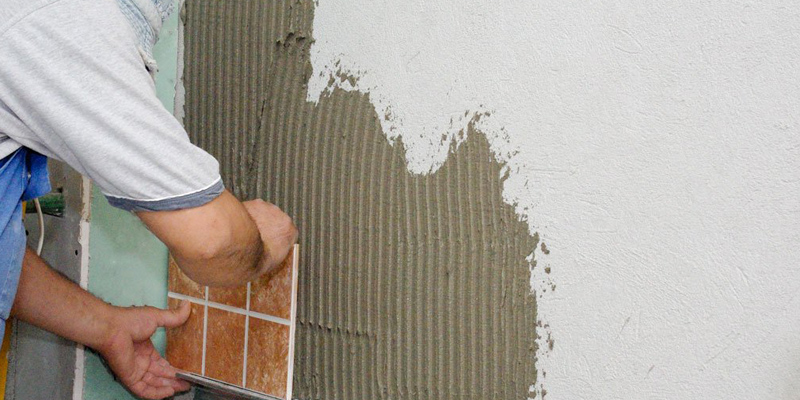Build a pyramid for diagonal tiles
Diagonal layout
The usual way to lay tile diagonally is to mark 45-degree diagonal lines on the wall or floor. But when that angle isn’t 45 degrees, as with the diamond-shaped tile you see here, getting exact lines is even harder. So we’ll show you a better way: Mark a single layout line and center the tiles over it by aligning the corners of the tile with the line. Build a pyramid centered on the line and use the sides of the pyramid to align each diagonal course. Check the sides of the pyramid occasionally with a straightedge.
Create Your Own Floor Tile Layout
Planning the layout for a tile project is usually the hardest and most time- consuming step. Watch this video to learn how a pro does it. You’ll see how to snap chalk lines and make sure they are perfectly square. Plus, you’ll learn how to avoid unsightly narrow, difficult-to-cut tiles along a wall. Don’t start a tile project until you’ve watch this video!
Special mortar for big tiles
Specialty thin-set mortar
Thin-set mortar is the best bedding adhesive for most tile. But if you’re setting tiles larger than 12 x 12 in., look for terms like “medium bed,” “large tile” or “large format” on the bag label. Bigger tile requires a thicker bed, and unlike standard thin-set, medium-bed mortar doesn’t lose its bonding strength when you lay it on thick. It’s also firmer and shrinks less, so tiles stay in position better while the mortar hardens. Medium-bed mortar is available at tile stores and some home centers.
Size a niche to suit the tile
Layout tip
If you’re planning a wall niche, lay out the tile and take some measurements to determine the size of the niche. If you custom-size the niche to fit between full tiles, you’ll get a better-looking installation and avoid some cutting. With a diagonal tile layout like the one shown here, you’ll get full tiles and half tiles. If trim will frame the niche, be sure to factor it into the layout.
A Symmetrical Niche
By building features like this wall niche based on the size and layout of the tile, you can create designs that look balanced and symmetrical.
The finished niche!
Eliminate lippage
Align tile edges
“Lippage” is the technical term for uneven tile edges (though “@%&#” is more common). Lippage is hard to avoid with large tile and easy to see with narrow grout lines or tile that has square—rather than rounded—edges. In any of those circumstances, leveling clips and wedges help you lay tile flat. Just slip the clip under the tile and push in the wedge. After the thin-set hardens, break off the exposed clip. LASH brand clips are available at tile stores and some home centers.
Clean cuts in porcelain
Step 1: Score
Make a shallow cut across the tile—about 1/8 in. deep. This minimizes chipping.
Porcelain tile is incredibly hard—and incredibly brittle. So it often chips along cuts or cracks before the cut is complete. Here’s a three-step routine that eliminates those problems. The first step only works with saws that allow you to adjust the depth of cut. If yours doesn’t, you can still make the second and third cuts to avoid cracks.
Gentle smudge remover
Clean-up aid
When you’re shopping for tile supplies, take a detour to the sandpaper aisle and pick up a pack of fine abrasive pads. Along with a little water, they’re great for removing stubborn thin-set smudges on the face of tile. And they won’t scratch the glossy glaze.
Don’t trust this chart
Coverage guidelines
Your thin-set probably has a chart like this on the label. Don’t rely on it. The recommendations are a good starting point, but they don’t guarantee a thin-set bed thick enough to provide full contact with the tile. And without full contact, you don’t get full support or adhesion.
As the chart shows, larger tiles require larger trowel notches (to provide a thicker bed). But other factors matter too: the flatness of the wall or floor, or the texture of the tile’s back. So the only reliable way to know that the bed is thick enough is to set the first few tiles, then immediately pry them up. If the tile hasn’t made full contact, you’ll see it. The easiest solution is to use the next notch size. With tiles larger than 12 in., it’s a good idea to also “back butter” them with thin-set. Also keep an eye on “squeeze-out” during the job. If you don’t see thin-set squeezing out between tiles, pull up a tile to check coverage.
Get a handle on tile
Quick pick up
A suction cup lets you lift a sunken tile or adjust a crooked one. Some home centers and hardware stores carry them; most don’t. To shop online, search for “suction cup handle.” Keep in mind that they only work on smooth-faced tile.
Big cuts without a big saw
Budget tile saw
Huge tiles are popular these days, and the best way to cut them is with a big, expensive tile saw. Here’s the next best way: a handheld wet saw guided by a straightedge (we used a plywood scrap). The saw shown here, along with the three-step cutting method shown above, gave us perfectly straight cuts in porcelain tile (but with some chipping). A cement-mixing tub caught most of the mess.
Absolutely essential trowel
Margin trowel
Tile setters use a margin trowel for everything: prying up sunken tiles, nudging crooked ones, cleaning out grout lines, mixing up small batches of thin-set or grout, scooping mix out of the bucket and scraping up messes. Makes a great back scratcher, too. If you’re setting tile, you’ve got to have one (sold at home centers).
Built-out trim
Depth adjustment
If you’re using tile trim, it’s often necessary to “build out” the trim so it protrudes from the field tile. A strip of tile backer can help you get the build-out just right. Any kind of backer board will do; just slather one side with thin-set or mastic and stick it in place. Here the trim wasn’t quite thick enough to overhang the tile below, so we set the trim over a strip of 1/4-in. backer. To make adjustments of less than 1/4 in., you don’t need a strip of backer; just apply a heavier bed of thin-set.
A rag that’s always there
Hand cleaner
An old shirt makes wiping your hands quick and convenient. And that keeps thin-set smudges off the tile. When the job is done, just toss it. Bet you have some shirts that belong in the trash anyway.
Tough scrubber for tools
Tool cleaner
Thin-set today is a lot stickier and tougher than it used to be. That’s a good thing for your tile job, but not so good for your tools. For easier cleanup, toss a coarse sanding sponge (sold at home centers) into your water bucket. The grit cuts through partially dried thin-set or grout. And unlike rags or sponges, it doesn’t snag on the teeth of notched trowels.
Required Tools for this Project
Have the necessary tools for this DIY project lined up before you start—you’ll save time and frustration.
- Bucket
- Grout float
- Level
- Nippers
- Notched trowel
- Rags
- Safety glasses
- Sanding block
- Tape measure
- Utility knife
You’ll also need a tile saw, margin trowel, abrasive pads and a suction cup.
Required Materials for this Project
Avoid last-minute shopping trips by having all your materials ready ahead of time. Here’s a list.
- Alignment clips
- Thin-set mortar
- Tile
- Tile backer
- Tile spacers












Recent Comments